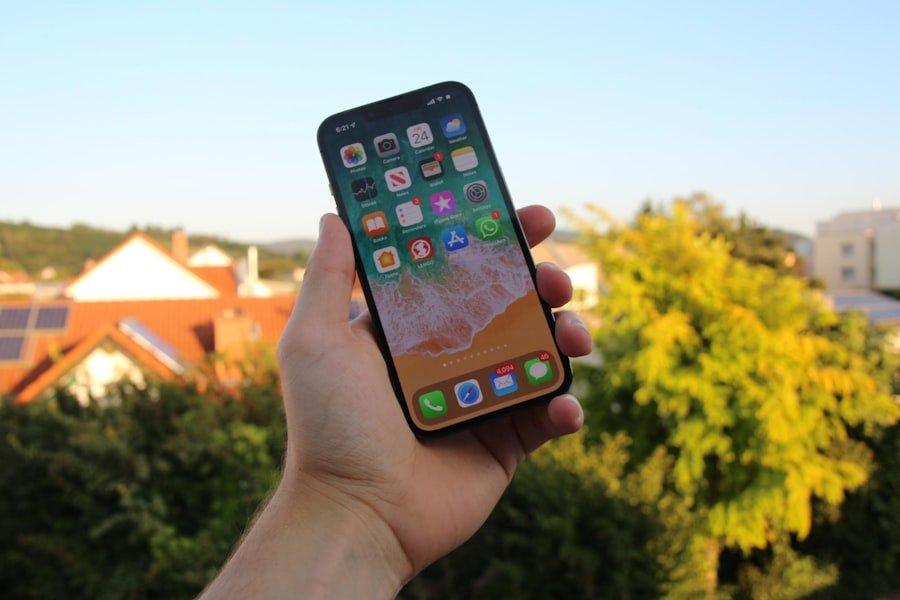In an increasingly digital world, the need for efficient file management has never been more critical. One common task that many iPhone users encounter is the need to save photos in a format that is both versatile and universally accessible. The Portable Document Format (PDF) has emerged as a popular choice for this purpose.
PDFs are not only compact and easy to share, but they also preserve the quality and layout of images, making them ideal for various applications, from professional presentations to personal keepsakes. Understanding how to convert and save photos as PDFs on an iPhone can significantly enhance your ability to manage and share visual content. The process of saving photos as PDFs on an iPhone is straightforward, thanks to the built-in features of iOS.
Users can leverage the native capabilities of the Photos app or utilize third-party applications designed for this purpose. This flexibility allows for a range of options depending on individual preferences and needs. Whether you are looking to compile a series of images into a single document for a project or simply want to archive cherished memories in a more manageable format, knowing how to convert photos to PDF can streamline your workflow and improve your overall digital experience.
Key Takeaways
- Saving photos as PDF on iPhone is a convenient way to store and share images in a compact and easily accessible format.
- Step-by-step instructions for saving a photo as PDF on iPhone include opening the Photos app, selecting the desired photo, tapping the share button, and choosing the “Save as PDF” option.
- Benefits of saving photos as PDF on iPhone include preserving image quality, reducing file size, and compatibility with various devices and platforms.
- Tips for organizing and managing PDF photos on iPhone involve using folders, tags, and naming conventions to keep the digital photo library tidy and easily searchable.
- Sharing PDF photos from iPhone to other devices can be done through email, messaging apps, cloud storage services, or direct transfer methods like AirDrop.
Step-by-Step Instructions for Saving a Photo as PDF on iPhone
To begin the process of saving a photo as a PDF on your iPhone, first, open the Photos app. Navigate to the album or location where the desired image is stored. Once you have located the photo, tap on it to open it in full view.
In the bottom left corner of the screen, you will see a share icon, which resembles a square with an upward arrow. Tapping this icon will present you with various sharing options. From the share sheet that appears, scroll down until you find the option labeled “Print.” Although this may seem counterintuitive, selecting “Print” is a crucial step in converting your photo to a PDF.
After tapping “Print,” you will be taken to a print options screen. Here, you will see a preview of your image. Instead of selecting a printer, use a two-finger outward pinch gesture on the preview image.
This action will transform the image into a PDF document. Once you have done this, tap the share icon again in the upper right corner of the screen to save or share your newly created PDF.
Benefits of Saving Photos as PDF on iPhone

Saving photos as PDFs on an iPhone offers numerous advantages that cater to both personal and professional needs. One significant benefit is the preservation of image quality. When photos are converted to PDF format, they maintain their resolution and clarity, ensuring that details are not lost during the conversion process.
This is particularly important for users who may need to print these images later or include them in presentations where visual fidelity is paramount. Another advantage is the ease of sharing and compatibility across different platforms. PDFs can be opened on virtually any device, regardless of the operating system, making them an ideal choice for sharing images with friends, family, or colleagues who may not use Apple products.
Additionally, PDFs can be easily attached to emails or uploaded to cloud storage services without worrying about file size limitations that often accompany high-resolution images. This versatility makes PDFs an excellent option for archiving important memories or professional documents.
Tips for Organizing and Managing PDF Photos on iPhone
| Tip | Description |
|---|---|
| Use Albums | Create albums to categorize and organize your PDF photos. |
| File Naming | Use descriptive file names to easily identify and manage PDF photos. |
| Backup Regularly | Backup your PDF photos to a cloud storage or computer to prevent data loss. |
| Use Editing Tools | Utilize editing tools to enhance and modify your PDF photos directly on your iPhone. |
| Sort by Date | Sort PDF photos by date to easily locate and manage recent or older photos. |
Once you have saved photos as PDFs on your iPhone, effective organization becomes essential for easy access and retrieval. One practical approach is to create dedicated folders within your Files app or cloud storage service where you can store these PDFs systematically. For instance, you might categorize them by event, date, or subject matter—such as vacations, family gatherings, or work-related projects.
This method not only simplifies finding specific documents but also helps maintain a clutter-free digital environment. Another useful tip is to utilize naming conventions that make it easier to identify the contents of each PDF at a glance. Instead of generic names like “Image1” or “Photo2,” consider using descriptive titles that include relevant details such as the date and event name (e.g., “2023-07-04_Family_BBQ.pdf”).
This practice enhances searchability and allows you to quickly locate specific files without having to open each one individually. Additionally, regularly reviewing and updating your PDF library can help ensure that outdated or unnecessary files are removed, keeping your digital space organized and efficient.
Sharing PDF Photos from iPhone to Other Devices
Sharing PDF photos from your iPhone to other devices is a seamless process that can be accomplished through various methods. One of the most straightforward ways is via AirDrop, Apple’s proprietary file-sharing feature that allows users to send files wirelessly between compatible devices. To use AirDrop, ensure that both Bluetooth and Wi-Fi are enabled on your iPhone and the receiving device.
Open the Files app or Photos app, select the PDF you wish to share, tap the share icon, and choose the AirDrop recipient from the list of nearby devices. Alternatively, you can share PDFs through email or messaging apps. Simply select the PDF file you want to send, tap the share icon, and choose your preferred email or messaging platform from the options provided.
This method is particularly useful for sending documents to individuals who may not be in close proximity or do not have AirDrop enabled on their devices. Furthermore, cloud storage services like Google Drive or Dropbox offer another avenue for sharing PDFs; by uploading your files to these platforms, you can generate shareable links that allow others to access your documents easily.
Troubleshooting Common Issues when Saving Photos as PDF on iPhone

While saving photos as PDFs on an iPhone is generally a smooth process, users may occasionally encounter issues that hinder their efforts. One common problem is related to software glitches or outdated operating systems. If you find that the Print option does not appear when attempting to convert an image to PDF, it may be beneficial to check for any available updates for your iOS version.
Keeping your device updated ensures that you have access to the latest features and bug fixes that can resolve such issues. Another potential hurdle involves file size limitations when sharing PDFs via email or messaging apps. If you attempt to send a large PDF file and receive an error message indicating that it exceeds size limits, consider compressing the file before sharing it.
Various apps are available in the App Store that can help reduce file sizes without significantly compromising quality. Additionally, if you experience difficulties with AirDrop connectivity, ensure that both devices are within close range and that AirDrop settings are configured correctly—set to “Everyone” if necessary.
Comparison of Different Apps for Saving Photos as PDF on iPhone
While the built-in functionality of iOS allows users to save photos as PDFs easily, several third-party applications offer enhanced features and capabilities for those seeking more robust solutions. One popular option is Adobe Scan, which not only converts images into PDFs but also includes advanced scanning features such as text recognition (OCR) and automatic cropping. This app is particularly useful for users who frequently need to digitize documents or create professional-quality PDFs from images.
Another noteworthy application is PDF Expert by Readdle, which provides comprehensive tools for managing PDF files beyond simple conversion.
Users can annotate, edit text, fill out forms, and even merge multiple PDFs into one document. This versatility makes it an excellent choice for professionals who require more than just basic photo-to-PDF conversion capabilities.Additionally, apps like Scanner Pro offer similar functionalities with user-friendly interfaces designed for quick scanning and conversion tasks.
Conclusion and Final Thoughts on Saving Photos as PDF on iPhone
The ability to save photos as PDFs on an iPhone opens up a world of possibilities for managing and sharing visual content effectively. With straightforward steps available through native apps and enhanced functionalities offered by third-party applications, users can easily convert their images into a versatile format suitable for various purposes. The benefits of preserving image quality and ensuring compatibility across devices make PDFs an attractive option for both personal memories and professional documentation.
As users become more adept at organizing their PDF photos and sharing them across platforms, they will find that this skill not only enhances their digital experience but also streamlines workflows in both personal and professional contexts. By exploring different applications and utilizing effective organizational strategies, iPhone users can maximize their efficiency in managing visual content while enjoying the convenience that comes with saving photos as PDFs.
If you are looking for more tips and tricks on how to manage photos on your iPhone, you may want to check out this article on how to organize your photo library. This article provides helpful advice on how to efficiently sort and categorize your photos to make them easier to find and access. It’s a great resource for anyone looking to streamline their photo management process.
FAQs
What is a PDF file?
A PDF (Portable Document Format) file is a file format used to present and exchange documents reliably, independent of software, hardware, or operating system.
How can I save a photo as a PDF on iPhone?
To save a photo as a PDF on iPhone, you can use the built-in feature in the Photos app. Open the photo you want to save, tap the share button, and then select “Print”. Pinch outwards on the photo preview to open it in full screen, then tap the share button again and select “Save to Files”. Choose a location and tap “Save” to save the photo as a PDF.
Can I convert multiple photos into a single PDF on iPhone?
Yes, you can convert multiple photos into a single PDF on iPhone using the same method mentioned above. Simply select multiple photos in the Photos app, tap the share button, and then follow the steps to save them as a single PDF file.
Are there any third-party apps that can help save photos as PDF on iPhone?
Yes, there are several third-party apps available on the App Store that can help you save photos as PDF on iPhone. These apps offer additional features and customization options for creating PDF files from photos.
